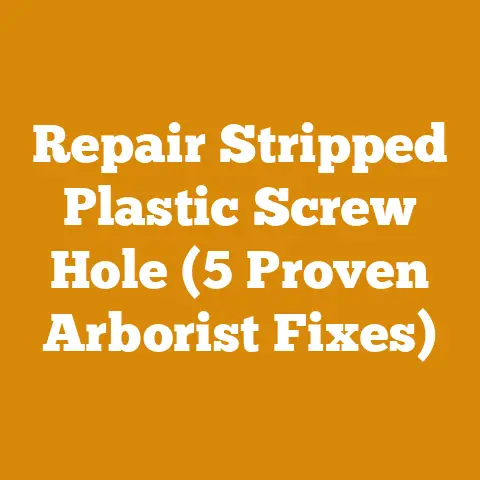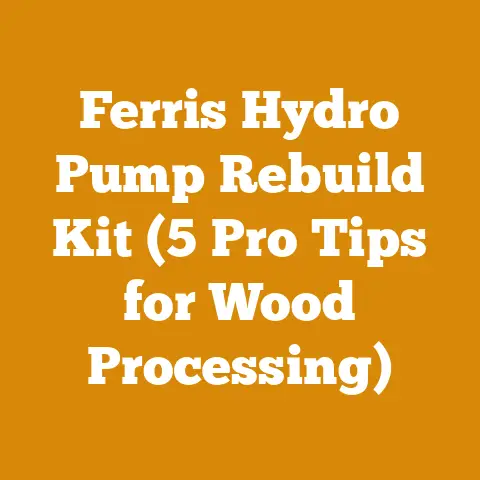DIY Outdoor Wood Burner (5 Expert Tips for Efficient Heat)
DIY Outdoor Wood Burner: 5 Expert Tips for Efficient Heat
In an era increasingly focused on sustainability, the allure of a DIY outdoor wood burner extends beyond mere functionality. It represents a connection to nature, a step towards self-reliance, and a potentially cost-effective way to heat your outdoor spaces. But building an efficient outdoor wood burner isn’t just about stacking some logs and lighting a match. It’s about understanding the science of combustion, selecting the right materials, and employing smart design principles. And crucially, it’s about understanding the costs involved so you can make informed decisions.
1. Design for Efficient Combustion: The Heart of the Matter
The cornerstone of any efficient wood burner is its combustion chamber. This is where the magic happens – where wood transforms into heat. A well-designed combustion chamber maximizes heat extraction and minimizes smoke production.
-
The Importance of Primary and Secondary Air: Efficient combustion requires two stages of air supply. Primary air fuels the initial burning of the wood. Secondary air, introduced higher in the chamber, burns off the unburnt gases and particulates that would otherwise escape as smoke. This secondary combustion significantly increases efficiency and reduces pollution.
-
Designing the Chamber: For a DIY project, consider a two-chamber design. The lower chamber holds the wood and receives primary air through vents at the bottom or sides. The upper chamber is designed to preheat and introduce secondary air, often through a series of small holes or a perforated pipe.
-
Materials Matter: The material you choose for your combustion chamber will impact both its efficiency and its lifespan. Steel is the most common choice due to its durability and heat resistance. However, the gauge of the steel is crucial. Thin steel will warp and burn through quickly, while thick steel is more expensive but will last much longer.
Cost Considerations:
-
Steel Costs: I’ve found that prices for steel sheets vary wildly depending on location and supplier. Expect to pay anywhere from \$0.50 to \$2.00 per pound for mild steel, depending on the gauge and your supplier. A simple cylindrical fire pit using ¼-inch thick steel could easily cost \$200-\$500 in materials alone.
-
Alternative Materials: Some DIYers use repurposed materials like old propane tanks or steel drums. While these can be cost-effective, be extremely cautious. Ensure the tank is completely empty and has been properly purged before cutting or welding. The cost here could be minimal, but the risk is high.
-
Welding Costs (if applicable): If you’re not a welder yourself, you’ll need to factor in the cost of hiring a professional. Welding rates typically range from \$50 to \$100 per hour. A simple fire pit could take 2-4 hours to weld, adding another \$100-\$400 to your total cost.
Data Point: A study by the EPA found that well-designed wood stoves with secondary combustion can be up to 50% more efficient than traditional open fireplaces.
Personal Experience: I once tried to cut corners by using thinner steel for a fire pit project. It warped after only a few uses, and I ended up having to rebuild the entire thing. Lesson learned: invest in quality materials from the start.
2. Optimize Airflow: The Breath of Fire
Airflow is paramount. Without proper airflow, your wood burner will smolder, producing smoke and minimal heat.
-
Primary Air Intake: The size and placement of the primary air intake are critical. Too little air, and the fire will suffocate. Too much air, and the fire will burn too quickly, wasting fuel. Experiment with different vent sizes and placements to find the optimal balance.
-
Secondary Air Injection: As mentioned earlier, secondary air is essential for burning off unburnt gases. The key is to preheat the secondary air before it enters the combustion chamber. This can be achieved by routing the air through a channel that runs around the outside of the chamber, allowing it to absorb heat from the fire.
-
Chimney Effect: A tall chimney creates a strong draft, drawing air into the combustion chamber and pulling smoke away from the burning wood. The height and diameter of the chimney will affect the draft. A chimney that’s too short or too narrow will restrict airflow, while a chimney that’s too tall or too wide will cool the exhaust gases, reducing the draft.
Cost Considerations:
-
Chimney Costs: Chimney pipes can be surprisingly expensive. Stainless steel chimney pipes typically cost \$30 to \$60 per foot. A 10-foot chimney could easily add \$300 to \$600 to your project cost. Cheaper galvanized steel options are available, but they’re not as durable and may not be suitable for high-temperature applications.
-
Damper Costs: A damper allows you to control the airflow through the chimney, which can help regulate the burn rate and prevent backdrafts. Dampers typically cost \$20 to \$50, depending on the size and type.
-
DIY Airflow Solutions: Get creative! I’ve seen DIYers use old metal pipes, perforated sheets, and even repurposed car parts to create effective airflow systems. The key is to experiment and see what works best for your design.
Data Point: According to the National Fire Protection Association (NFPA), improper chimney installation is a leading cause of house fires. Always follow local building codes and regulations when installing a chimney.
Personal Experience: I once helped a friend troubleshoot a smoky wood stove. We discovered that the chimney was partially blocked by a bird’s nest. Clearing the obstruction dramatically improved the airflow and eliminated the smoke problem.
3. Choose the Right Wood: Fueling the Flame
The type of wood you burn has a significant impact on its heat output and burning characteristics.
-
Hardwoods vs. Softwoods: Hardwoods, like oak, maple, and ash, are denser than softwoods, like pine and fir. This means they contain more energy per volume and will burn longer and hotter. Softwoods, on the other hand, ignite easily and burn quickly, making them good for starting fires but less ideal for sustained heating.
-
Seasoning is Key: Green wood contains a high moisture content, which reduces its heat output and increases smoke production. Seasoning wood involves allowing it to dry for at least six months, preferably longer. The longer the wood dries, the more efficient it will burn.
-
Wood Species and BTU Content: Different wood species have different BTU (British Thermal Unit) content, which is a measure of their energy content. Oak, for example, has a higher BTU content than pine.
Cost Considerations:
-
Firewood Prices: Firewood prices vary depending on location, wood species, and the quantity purchased. Expect to pay anywhere from \$150 to \$400 per cord for seasoned hardwood. A cord is a stack of wood that measures 4 feet high, 4 feet wide, and 8 feet long. Softwood is generally cheaper, but it burns faster, so you’ll need more of it.
-
Harvesting Your Own Wood: If you have access to a wooded area, you can harvest your own wood. However, this involves significant labor and equipment costs. You’ll need a chainsaw, splitting maul, wedges, and a way to transport the wood.
-
Chainsaw Costs: A decent chainsaw for felling trees and cutting firewood can cost anywhere from \$200 to \$800, depending on the brand, size, and features. Don’t forget to factor in the cost of fuel, oil, and maintenance.
-
Splitting Maul Costs: A good splitting maul can cost \$50 to \$100. Splitting wood by hand is hard work, but it’s a good way to save money and get some exercise.
-
Labor Costs (Your Time): Don’t forget to factor in the value of your own time. Harvesting and splitting a cord of wood can take several days of hard labor. Is your time worth more than the cost of buying firewood?
Data Point: A study by the Department of Energy found that burning seasoned hardwood can be up to 30% more efficient than burning green softwood.
Personal Experience: I once made the mistake of burning unseasoned wood in my wood stove. It produced so much smoke that my neighbors complained, and I had to shut it down. It was a smelly, inefficient, and embarrassing experience.
4. Insulation and Heat Retention: Keeping the Warmth In
Insulating your outdoor wood burner can significantly improve its efficiency by preventing heat loss.
-
Insulating Materials: There are several ways to insulate a wood burner. One option is to use firebricks to line the combustion chamber. Firebricks are designed to withstand high temperatures and retain heat. Another option is to wrap the outside of the chamber with insulating material, such as mineral wool or ceramic fiber blankets.
-
Heat Retention Features: Consider adding features that help retain heat, such as a thermal mass around the combustion chamber. This could be a layer of stone, brick, or concrete. The thermal mass will absorb heat from the fire and slowly release it over time, providing a more consistent heat output.
-
Reflective Surfaces: Painting the inside of the combustion chamber with a high-temperature reflective paint can help bounce heat back into the fire, increasing its efficiency.
Cost Considerations:
-
Firebrick Costs: Firebricks typically cost \$2 to \$5 per brick. Lining a small combustion chamber could require 50 to 100 bricks, adding \$100 to \$500 to your project cost.
-
Insulation Costs: Mineral wool and ceramic fiber blankets typically cost \$1 to \$3 per square foot. Wrapping the outside of a combustion chamber could require 10 to 20 square feet of insulation, adding \$10 to \$60 to your project cost.
-
Thermal Mass Costs: The cost of adding a thermal mass will depend on the materials you choose. Stone and brick can be relatively expensive, while concrete is more affordable.
Data Point: A study by the Oak Ridge National Laboratory found that insulating a wood stove can increase its efficiency by up to 15%.
Personal Experience: I once built a small outdoor pizza oven using firebricks. The firebricks retained heat so well that I could bake pizzas for hours with just a small amount of wood.
5. Safety First: Protecting Yourself and Your Property
Safety should always be your top priority when building and using an outdoor wood burner.
-
Location, Location, Location: Choose a location that is away from flammable materials, such as trees, bushes, and buildings. Make sure the area around the wood burner is clear of debris.
-
Spark Arrestor: Install a spark arrestor on the chimney to prevent sparks from escaping and potentially starting a fire.
-
Fire Extinguisher: Keep a fire extinguisher nearby in case of emergencies.
-
Carbon Monoxide Detector: If you’re using the wood burner in an enclosed space, such as a garage or shed, install a carbon monoxide detector.
-
Building Codes: Check your local building codes and regulations before building a wood burner. Some areas have restrictions on the type of wood burners that are allowed and require permits for installation.
Cost Considerations:
-
Spark Arrestor Costs: Spark arrestors typically cost \$20 to \$50, depending on the size and type.
-
Fire Extinguisher Costs: A good fire extinguisher can cost \$30 to \$100.
-
Carbon Monoxide Detector Costs: Carbon monoxide detectors typically cost \$20 to \$50.
-
Permit Costs: Permit costs vary depending on your location. Contact your local building department for more information.
Data Point: According to the Consumer Product Safety Commission (CPSC), there are approximately 25,000 residential fires caused by wood stoves and fireplaces each year.
Personal Experience: I once witnessed a brush fire that was started by sparks from a wood stove. Fortunately, the fire was quickly extinguished, but it served as a reminder of the importance of fire safety.
Budgeting for Your DIY Outdoor Wood Burner Project: A Real-World Example
Let’s break down a hypothetical budget for a DIY outdoor wood burner project, using the principles we’ve discussed. We’ll assume a moderately sized, cylindrical fire pit with a two-chamber combustion design.
Assumptions:
- Location: Rural area with access to steel suppliers.
- Skill Level: Intermediate DIYer with basic welding skills.
- Wood Source: Purchasing seasoned hardwood firewood.
Cost Breakdown:
-
Materials:
- Steel (¼-inch thick): \$300 – \$600 (depending on size and supplier)
- Chimney Pipe (10 feet stainless steel): \$300 – \$600
- Firebricks (50 bricks): \$100 – \$250
- Insulation (mineral wool): \$30 – \$60
- Spark Arrestor: \$30 – \$50
- Damper: \$30 – \$50
- High-Temperature Paint: \$20 – \$30
- Fasteners (bolts, nuts, washers): \$20 – \$40
- Total Material Cost: \$830 – \$1740
-
Tools and Equipment:
- Welding Supplies (if needed): \$50 – \$100 (assuming you already have a welder)
- Cutting Tools (grinder, torch): \$50 – \$100 (assuming you already have these)
- Measuring Tools (tape measure, level): \$20 – \$40 (assuming you already have these)
- Safety Gear (welding helmet, gloves): \$50 – \$100 (assuming you already have these)
- Total Tool Cost: \$170 – \$340
-
Labor:
- Your Time (estimated 20 hours at \$20/hour): \$400 (opportunity cost – what you could be earning doing something else)
-
Firewood:
- One Cord of Seasoned Hardwood: \$250 – \$400 (this is an ongoing expense)
-
Permits (if required):
- Permit Fees: Variable, check local building codes. Let’s estimate \$50 – \$100
Total Project Cost (Initial Investment):
- Low-End Estimate: \$1450
- High-End Estimate: \$2580
Important Considerations:
- Contingency Fund: Always add a contingency fund (10-20%) to cover unexpected costs.
- Salvaged Materials: Sourcing salvaged materials (steel drums, bricks) can significantly reduce costs. But always prioritize safety.
- Long-Term Fuel Costs: Factor in the ongoing cost of firewood. Consider alternative fuel sources (wood pellets, biofuel) if they are more cost-effective in your area.
Data Insight: According to HomeAdvisor, the average cost to install a professionally built outdoor fireplace ranges from \$2,000 to \$10,000. A DIY project can save you significant money, but it requires time, skill, and careful planning.
Expert Tips for Cost Optimization:
- Shop Around for Materials: Get quotes from multiple suppliers to find the best prices on steel, firebricks, and other materials.
- Consider Used Equipment: Look for used welding equipment and other tools on online marketplaces or at pawn shops.
- Barter Your Skills: Offer your skills (welding, carpentry) in exchange for materials or labor.
- Harvest Your Own Wood (Responsibly): If you have access to a wooded area, consider harvesting your own wood. But be sure to follow sustainable forestry practices and obtain any necessary permits.
- Build in Stages: Break the project into smaller, more manageable stages to spread out the costs over time.
- Don’t Skimp on Safety: Investing in safety gear and following proper safety procedures is essential. The cost of an accident can far outweigh the cost of safety precautions.
Actionable Takeaways:
- Plan Your Design Carefully: A well-designed wood burner will be more efficient and cost-effective in the long run.
- Prioritize Quality Materials: Investing in quality materials will ensure that your wood burner lasts longer and performs better.
- Factor in All Costs: Don’t forget to factor in the cost of materials, tools, labor, fuel, and permits.
- Shop Around for the Best Deals: Get quotes from multiple suppliers and consider used equipment.
- Prioritize Safety: Always follow proper safety procedures and wear appropriate safety gear.
Building a DIY outdoor wood burner can be a rewarding and cost-effective project. By following these expert tips and carefully managing your budget, you can create an efficient and safe heating source that will provide years of enjoyment. Remember to factor in all costs, prioritize safety, and get creative with your design. With a little planning and effort, you can build a wood burner that’s both functional and beautiful. Good luck, and happy burning!






